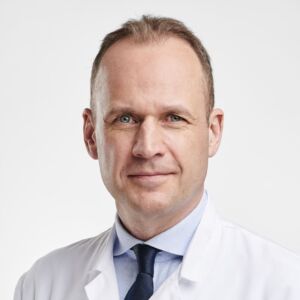Dilation of the aorta can be dangerous. However, an aortic aneurysm can be monitored well if detected early. An operation is not always necessary, explains vascular surgeon Alexander Zimmermann.
Mr. Zimmermann. How does an aneurysm develop?
The blood flow, the volume of blood and the different sized vessels lead to constant pressure on the body’s vessels. With age or due to deposits, the vessels lose elasticity, which can lead to weak points on the vessel walls and the formation of bulges over time. In medicine, such an enlargement of a certain size is referred to as an aneurysm.
Are there any figures on the frequency and occurrence in men and women?
Congenital aneurysms are very rare, most form during the course of life. In principle, aneurysms can form in all vessels. Dilation of the main artery, the aorta, is the most common form. Around 4-8 percent of men over 65 and 0.5 to 1.5 percent of women over 65 have such an aortic aneurysm.
Are there factors that favor the development?
The main factor is the normal aging process. However, the risk increases with all harmful influences on the cardiovascular system, such as smoking, high blood pressure, obesity and elevated blood lipid levels.
What are the risks associated with an aortic aneurysm?
Normally, the aorta has a diameter of 1.5 to 3 centimeters, depending on the location. An aortic dilation is said to be pathological from 3 centimeters, from about 5 to 5.5 centimeters an aortic dilation requires treatment. As the protrusion increases in size, the vessel wall stretches more and more like a balloon and can eventually rupture partially or completely, leading to bleeding inside the body. This is a life-threatening emergency that requires immediate surgery. Depending on its location, the aneurysm can affect the performance of the heart. If the aortic valve can no longer close properly due to vasodilation, every heartbeat washes blood back into the heart. The heart is constantly overloaded, which can lead to heart failure.
How is a dilated aorta recognized?
Like all aneurysms, aortic aneurysms usually do not cause any symptoms. It is therefore often discovered by chance, for example during an X-ray or ultrasound examination. Using special procedures and tests, we can then analyze and assess the size and nature of the aneurysm.
And how is treatment carried out after diagnosis?
With most aneurysms there is no acute danger. They simply need to be checked regularly to detect whether they are growing at an early stage. One important measure is lifestyle adjustment, i.e. giving up smoking, reducing excess weight and lowering blood pressure. If the aneurysm grows or threatens to rupture, it must be treated.
What methods are there to prevent a rupture of the aorta?
The affected section of the artery can be replaced by a prosthesis. For some patients it is sufficient to replace a short section, sometimes the entire aorta needs to be replaced. To ensure that the prosthesis fits perfectly, it is therefore customized for each patient. At the USZ, we can also place large prostheses that replace the entire aorta using minimally invasive techniques. Only a few small skin incisions are required, and the chest or abdominal cavity does not need to be opened. With this method, we can also help people who would otherwise not be able to undergo surgery due to their poor state of health.
Can an aneurysm be prevented?
It is not known exactly why and in whom an aortic aneurysm forms. However, there are a number of things you can do to minimize the risk of this happening. Everything that keeps the blood vessels fit contributes to this: No smoking, a healthy diet, reducing excess weight and regular monitoring of blood pressure, blood lipids and blood sugar levels. I think screening examinations of the aorta with ultrasound from a certain age make sense, but they are not (yet) standard in Switzerland. If there are already cases in your family, you should make your doctor aware of this.


